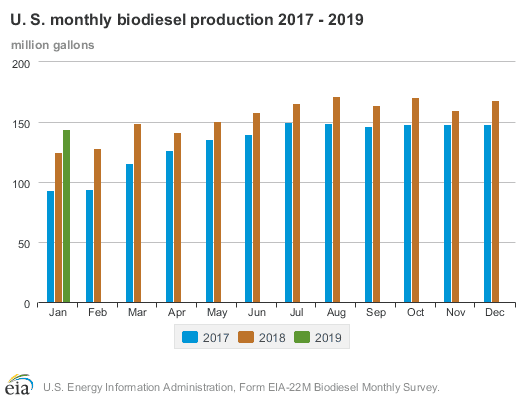What is biodiesel?
Biodiesel is a renewable, clean-burning diesel replacement that is reducing U.S. dependence on foreign petroleum, creating jobs and improving the environment. Biodiesel is commonly blended in a 5% to 20% component with petroleum diesel and can be found available at retail around North America as a blended fuel. Biodiesel is a low CO2, net energy positive fuel which depending on the feedstock it is made from can vary from a 30% to 80%+ reduction in CO2 emissions compared to petroleum diesel. Biodiesel is made from a diverse mix of feedstocks including recycled cooking oil, industrial non-food grade spent oils, animal fats, as well as virgin vegetable oils such as canola, soy, and corn oil. For more information see the National Biodiesel Board’s “Biodiesel Basics” page.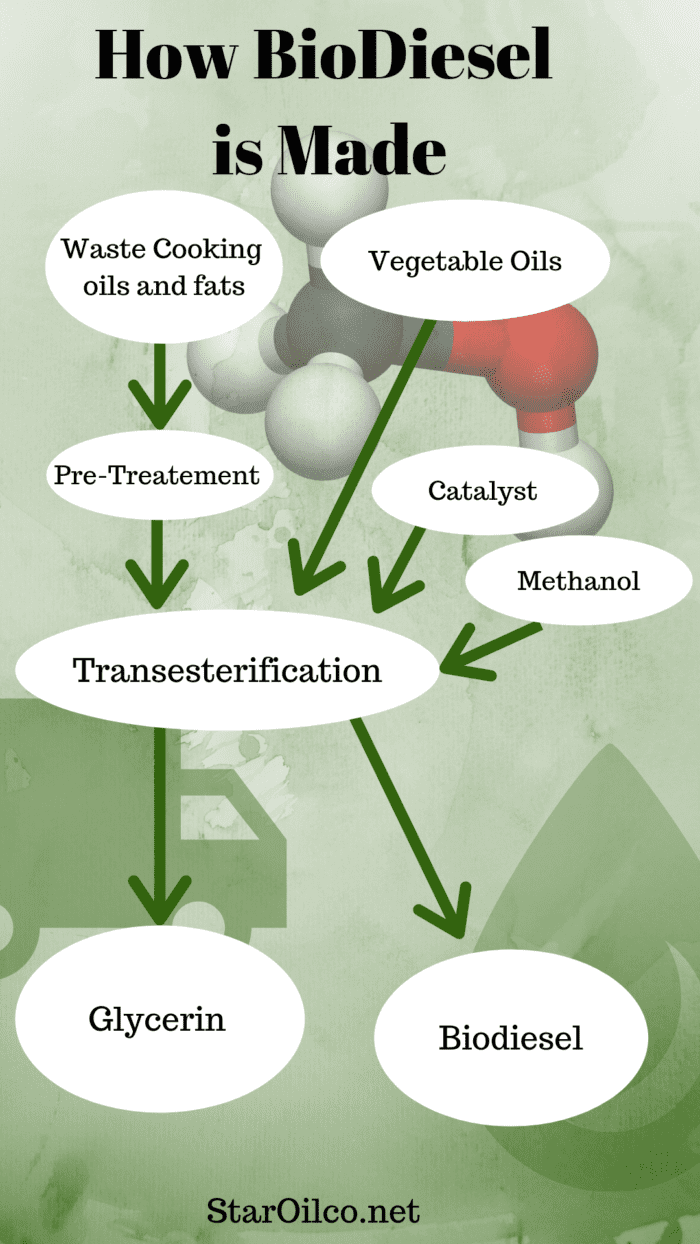
How is biodiesel made?
Biodiesel is most commonly made from taking an animal fat, used cooking oil, or a virgin vegetable oil and mixing it with an alcohol (such as methanol). This process is called transesterification and it creates two products glycerin and esters (usually methyl esters or alkyl esters which is the chemical name for most biodiesel). The crude biodiesel is then further processed to remove excess water and other impurities. The standards for commercially sold biodiesel in the US is ASTM D6751.
What does ASTM D6751 mean?
Biodiesel to be sold in the United States must meet an industry standard which is ASTM D6751. ASTM (American Society for Testing and Materials) D6751 is the specifications for B100 or 100% Biodiesel. Biodiesel is usually blended with diesel fuel for retail sale. This specification defines the properties of the biodiesel from the refiner prior to sale to the public. The properties include things like flashpoint, water content, oxidative stability, sulfur ppm (parts per million), and other specifics that this biodiesel needs to be at in order to hit these standards (Source).
Once a fuel is within all these properties it can be blended with diesel, which has its own ASTM standards, for more about ASTM D975 and other fuel specification concerns please see the Changes in Diesel Fuel – Technicians Guide for more and very in depth information.
Can biodiesel be used in normal diesel engines? / Which cars use biodiesel?
Regardless of where you are in the United States there is a reasonable expectation of purchasing biodiesel in your diesel fuel. Formally, B5 is supported by all major OEMs selling diesel engines in the U.S. In 2016, at least 78 percent of diesel vehicles supported B20 (Source). Regardless of what your owner manual says about biodiesel fuel, B20 biodiesel is a proven fuel and is automatically presumed for any new diesels on the road. In many parts of the United States B20 is a commonly found fuel at retail stations, commercial cardlocks, and national truck stop chains.
In the Pacific Northwest, where low CO2 emission policy is front and center, biodiesel can be expected to be found in every gallon of diesel sold in some form.
Oregon law says “All diesel fuel sold in the state must be blended with at least 5% biodiesel (B5) if that fuel is going to be used in vehicles. For the purpose of this mandate, biodiesel is defined as a motor vehicle fuel derived from vegetable oil, animal fat, or other non-petroleum resources, that is designated as B100 and complies with ASTM specification D6751. Renewable diesel qualifies as a substitute for biodiesel in the blending requirement” (Source). Oregon and Washington has plenty of retail and commercial cardlock locations selling above 5% biodiesel as the defacto fuel given the incentives as well as low CO2 mandates in Oregon.
Can biodiesel be used for heating oil?
Yes. Biodiesel has been effectively used as a heating oil for over 20 years. In fact an in-depth report by the Sustainable Energy Technologies Department Energy Conversion Group shows that blends up to B50 can be used without needing to change or adjust your settings. Read our blog for a summary of this report.
Can biodiesel be mixed with conventional / regular diesel?
Most biodiesel that is sold is as a blended form with petroleum diesel. In a blend, the “B” stands for the amount of biodiesel that is included in the product. For example, B20 would be 20 percent biodiesel and 80 percent petroleum diesel. Biodiesel can also be combined with renewable diesel – a blend of B20 would be called B20/R80 diesel.
Can biodiesel be used in diesel generators?
Yes. In fact, Oregon is one of several states that require biodiesel be blended into all diesel fuels. That means this fuel has been used successfully in the fuel supply for years. As with any fuel that can sit for extended amounts of time, we recommend you take proper precautions, such as using additives, to ensure your fuel is ready to be used when needed. If this is a concern, please contact us – we would love to talk to you about your storage needs.
Can biodiesel be made from animal fat?
Yes, biodiesel refers to (according to the National Biodiesel Board) a methyl ester made from chemically reacting lipids with an alcohol to produce fatty acid esters. This is called transesterification. The lipids could be sourced from many different types of oils, such as vegetable, soybean or animal fat based oils/tallows. For a deeper dive into some of the different types of feedstocks, read our blog.
Can biodiesel be used in airplanes?
Yes and no. There have been several tests using biofuels but fuel for aircrafts is different than regular diesel. Fuel gels at a plane’s flying altitude so aircrafts can’t use regular diesel or biodiesel. Several tests with biofuels have proven successful. Read more about the use of biofuels in the future.
Can biodiesel freeze?
Gelling is the term used for diesel fuel starting to freeze. The paraffin present in diesel starts to solidify and at lower temperatures, it can start to solidify and crystallize. Some blends of biodiesel at B20 and higher will gell at a higher temperatures than petro diesel. During the winter months, it’s important to use additives that combat this or use lower percentages of biodiesel for your fuel. In low enough temperatures, even petro diesel will freeze.
Can biodiesel replace oil? / Can biodiesel replace diesel / fossil fuels?
At this time, no. While the quality of the fuel for biodiesel and renewable diesel is as high as the petrodiesel we have today, the production of these fuels can’t meet the demand that is needed. This has to do with available feedstock and infrasturcture to recycle usable wastes.
The long answer to this question, though, is YES. As technology advances, there may be a time that all fuel is derived from waste and plant crops instead of petroleum.
For an idea where the market is going and how much fuel we are using here is a little bit more information on current usage.
In the early 2000’s, the biodiesel market was about 25 million gallons. In 2016, the market had grown to 2.8 billion and it’s still increasing. The on-road diesel demand is 35 billion to 40 billion gallons. The industry goal is to be producing 10 percent of the transportation market by 2022 (Source).
Which biodiesel is best?
Biodiesel that meets the ASTM D6751 is the best. While making your own biodiesel isn’t hard, keeping the fuel filtered and free of excess water is challenging. Finding a reputable provider that uses fuel that meets specs and also filters and treats your fuel like Star Oilco helps ensure you’re using the best fuel possible.
Which is biodiesel plant/crop? What crop/plant produces/yield biodiesel?
Any plant that produces an oil can be used to produce biodiesel. The plants and crops that are most likely to be used, would produce a lot of oil for the amount of work that goes into growing them. Some of the experimental crops are ones that grow in areas that don’t produce quality food, like Camelina sativa. A member of the mustard family, it grows well in poor soil and harsh conditions and doesn’t displace crops that produce food.
Here are the blogs we have posted so far about some of the biodiesel feedstocks that have been tested and used.
Feedstock: Babassu oil & Beef Tallow
Feedstock: Borage Oil & Camelina Oil
Feedstock: Algae Oil & Canola Oil
Feedstock: Castor Oil and Choice White Grease
Feedstock: Coconut Oil and Coffee Oil
Feedstock: Evening Primrose Oil and Fish Oil
Feedstocks: Hemp Oil & High IV and Low IV Hepar
Feedstocks: Jatropha Oil, Jojoba Oil, & Karania Oil
Feedstocks: Lesquerella Oil & Linseed Oil
Feedstocks: Moringa Oil & Neem Oil
Feedstocks: Palm Oil & Perilla Seed Oil
Feedstocks: Poultry Fat & Rice Bran Oil
Which is better: biodiesel or diesel?
Biodiesel has advantages of producing lower emissions, providing lubricity to the moving parts and being produced in the United States.
Diesel is more abundant, is easily created from crude oil, and has a lower gel point.
Which is better depends on what you are looking for.
Which states mandate biodiesel?
According to AFMP (American Fuel & Petrochemical Manufacturers):
- Minnesota: Has a B2 requirement year round (September 2005) and a summer requirement of B20 (May 2018).
- Oregon: Requires a B5 reguirement year round (July 2007).
- Washington: Requires 2% of the diesel sold in Washington to be biodiesel (December 2008). This can be substituted with Renewable Diesel (July 2009).
- Pennsylvania: According to AFMP, “2% biodiesel for on-road compression ignition engines one year after annualized in-state production reaches 40 million gallons, 5% biodiesel (100 million gallons), 10% biodiesel (200 million gallons), and 20% biodiesel (400 million gallons)” (July 2008). Renewable diesel can substitute for up to 25% of this requirement, in addition to heating oil and off-road diesel (May 2011)
- New Mexico: Requires B5 for all diesel vehicles (July 2012).
Which countries produce biodiesel? / Which countries use biodiesel?
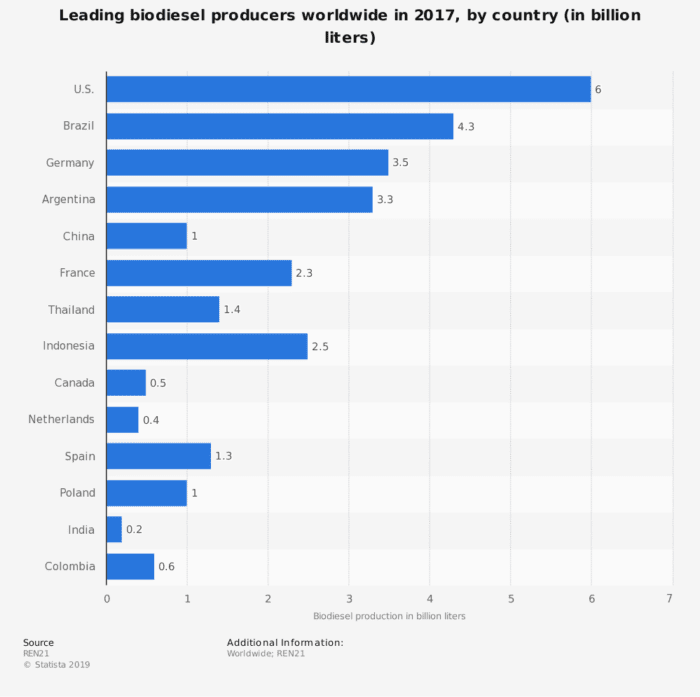
Biodiesel is produced around the world, led by the U.S., Brazil and Germany.
The US produced 6 billion liters in 2017 or about 1.6 billion gallons. This website has the exact numbers for 2017, 2018 and some of 2019 production of biodiesel in the U.S.
Biodiesel in the US is largely made from soybeans at this time.
Will biodiesel damage my engine? / Will biodiesel damage my car?
Biodiesel can be used in any car or engine that is using diesel. Biodiesel is a solvent this means that it may start cleaning the tank or pipes that previously just used petroleum fuel, for this reason fuel filters may clog initially.
How will biodiesel help save money?
It depends! If the price of a barrel of crude rises to a high level, biodiesel can be cheaper. In addition, if RIN’s are available (basically a credit for using biodiesel), they can lower the price of biodiesel and make it less expensive to use and purchase.
How will biodiesel help reduce pollution?
Petrodiesel uses crude oil, which is trapped CO2 from ages past. When it is burned, it releases this CO2 back into the air.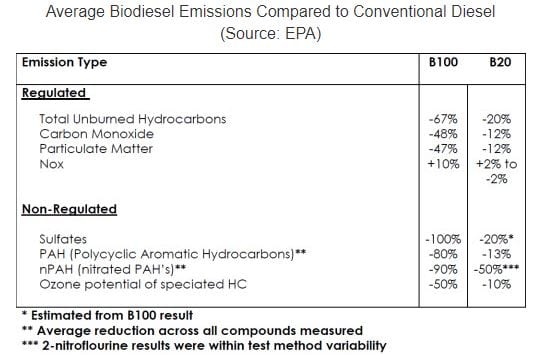 When you use biodiesel, you’re using CO2 that is being captured by the growing plants or the waste. This is current CO2 you aren’t adding to the net sum in the environment.
When you use biodiesel, you’re using CO2 that is being captured by the growing plants or the waste. This is current CO2 you aren’t adding to the net sum in the environment.
As for regular pollutants, here is a chart that shows what using biodiesel does compared to conventional diesel. There is a significant reduction to pollutants that are expressed through the exhaust.
How long will ecodiesel last? / How long can biodiesel be stored?
Diesel, including biodiesel, does go bad after awhile. Diesel fuels adhering to ASTM specification should be safe for storage up to a year without additional treatment and testing. If you are storing diesel for long term use, it is a good best practice to treat the fuel with a biocide and oxidative stabilizer to ensure that the fuel stays within specification and nothing will begin to grow in your fuel tank. The biggest enemy of long term diesel storage is water and dirt entering the fuel through a tank vent. As temperatures change, a tank will breath, pulling in air and moisture from outside. Keep your fuel within specification by ensuring there is no water in the tank and that outside contaminants can’t get into a tank.
Where biodiesel is used? / Where is biodiesel used in the world?
Biodiesel use is encouraged by many countries and usage has increased greatly since 2001. This graph from the U.S. Energy Information Administration shows that the U.S. used 2.1 billion in 2016 or about 22% of the total amount of biodiesel used that year. Wikipedia lists 31 countries and explains the amount of biodiesel they use each year. 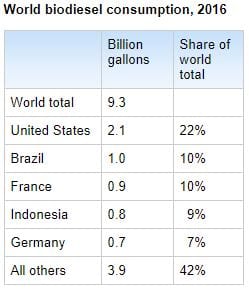
Where to buy biodiesel?
If you live in Oregon, every gas station has at least 5% biodiesel. Cardlock locations throughout the states have stations with biodiesel blends. For other locations, this site is a great resource.
Where can biodiesel be used?
Legally, it can be used anywhere although some biodiesel derived from palm oil is restricted in certain countries.
When / where was biodiesel invented?
The definition of diesel is a liquid that uses compression and oxygen to ignite without the use of a spark. Rudolf Diesel created the diesel engine in Germany. The design for engines first used coal dust suspended in water and later vegetable oils, such as peanut oil. These fuels were later abandoned when petroleum became abundant and cheaper to produce.
Where does biodiesel fuel come from?
In the United States, the primary source for biodiesel is soy beans. According to the U.S. Energy Information Administration, the feedstocks break down as such:
- Soybean Oil – 52%
- Canola Oil – 13%
- Corn Oil – 13%
- Recycled feedstocks – 12%
- Animal Fats – 10%
Even with Soybean oil as the primary source, the remaining meal is used to produce food for animal feed. For more information on feedstocks of biodiesel, here is an ongoing blog we have been working on to examine the resulting fuels produced by the various feedstock.
Where are biodiesel plants?
Here is a list of sites in the United States.
When did biodiesel begin?
The original diesel engine ran on peanut oil, so technically biodisesel was first used in the 1890s. Most oils in the 1800s were from bio stocks. It wasn’t until petroleum became abundant and thus cheaper that biofuels and oils were abandoned for this cheaper source.
When does biodiesel gel?
The feedstock determines when biodiesel will gel. The most common feedstock is soy, which has a cloud point of 0°C (32°F) for B100. Petroleum diesel has a cloud point of -45°C (-49°F) to -7°C (19°F) (Source). Cloud point refers to when the paraffin begins to crystallize and the fuel looks a little cloudy.
Biodiesel and petrodiesel is usually blended and this lowers the cloud point of biodiesel in the fuel considerably. In addition, additives are frequently added during cold weather that further lowers the cloud point.
When is biodiesel day celebrated?
National Biodiesel Day is March 18th, which is also Rudolf Diesel’s birthday. August 10th is International Biodiesel Day, a celebration of Rudolf Diesel’s prime model running for the first time on August 10, 1893.
Who invented biodiesel?
The diesel engine is defined by “any internal-combustion engine in which air is compressed to a sufficiently high temperature to ignite diesel fuel injected into the cylinder, where combustion and expansion actuate a piston.” Until petroleum was developed as a cheaper alternative, animal and vegetable oil was used. One of the first fuels used in the diesel engine was peanut oil, and thus biodiesel was born.
Can you use 100% Biodiesel even in the winter?
The answer is YES. While biodiesel has a lower cloud point then petroleum diesel there is a technology by Optimus Technologies called the Vector System. This allows a truck to start on regular diesel until it gets up to temp and switch over to run on up to 100% biodiesel. The City of Ames, Iowa is one success story of this technology. (Story Here)



